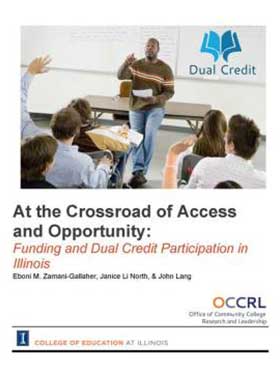As part of OCCRL’s continuing focus on dual credit education, I am excited to introduce the first in a series of blogs on dual credit that OCCRL will run monthly in 2016. Last year, we focused on the intersection between tuition schedules and access for underserved students in Illinois. In light of state funding cuts for dual credit over the past seven years, increasing tuition and fees alongside decreasing student enrollment would appear likely. However, just the opposite occurred among dual credit participants.
Between 2008 and 2013, dual credit enrollment in Illinois increased 23% from 70,000 to 90,000 (Corso, 2014). In our work, we found institutions such as Harper Community College had an increase in dual credit enrollment from 500 to 2,300 (2011-2015) and McHenry County College which experienced an increase from 33 to 916 between 2010 to 2014 (Zamani-Gallaher, North, & Lang, 2015). In addition, of the 26 colleges in our study, 21 offer a tuition-free dual credit option and 2 institutions offer a discounted tuition rate for dual credit courses. Illinois community college dual credit programs have been nimble and innovative in lieu of limited state funding reducing and/or alleviating tuition and fee costs subsequently making dual credit courses accessible, especially for underserved students. The findings from this study can be found in our recently released report, At the Crossroad of Access and Opportunity: Funding and Dual Credit Participation in Illinois.
We are also excited to feature an article by Kent Scheffel Vice President of Enrollment Services at Lewis and Clark Community College and President of the National Alliance of Concurrent Enrollment Partnerships (NACEP) in the upcoming OCCRL Update on Research and Leadership. Mr. Scheffel oversees one of the largest dual credit programs in Illinois. The program extends to 18 high schools in the district and is currently the only NACEP accredited program in Illinois. NACEP standards and accreditation are designed to promote policies and practices that help to ensure college-level quality of concurrent enrollment courses.
We look forward to featuring timely issues pertinent to dual credit, including but not limited to weighing dual credit programs and advance placement programs, teacher credentials, dual credit accreditation, and online models of dual credit and more. In all, we hope to provide you stimulating commentary on important contributions, opportunities, and challenges with concurrent enrollment at the state, regional, and national level. Please join us in sharing your thoughts on accelerated learning and best practices in dual credit!
References- Corso, A. (2014, September 23). The state of dual credit. Presented at Forum for Illinois State University, Normal, IL.
- Zamani-Gallaher, E.M., North, J.L., & Lang, J. (2015, August). At the Crossroad of Access and Opportunity: Funding and Dual Credit Participation in Illinois Champaign, IL: Office of Community College Research and Leadership, University of Illinois at Urbana-Champaign.
